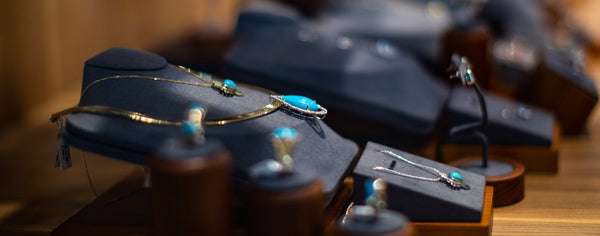Jewelry appraisals protect your valuable pieces in the event of damage, loss, or theft. Without a proper evaluation of your jewelry’s worth, you can’t get insurance coverage for it. That means you’re out of luck if something happens to your precious trinkets and they’re not covered.
Knowing you need estimated values and understanding the appraiser’s report once it’s available are two different things.
Whether you’re a jewelry enthusiast or someone seeking to appraise your precious gems, our comprehensive guide on decoding jewelry appraisals gives you all the knowledge you need. Some of the questions we answer include:
- What is a jewelry appraisal?
- Who performs jewelry appraisals?
- What factors influence jewelry value?
- What is the jewelry appraisal process?
What is a jewelry appraisal?
A jewelry appraisal is a professional assessment of the value of a piece of jewelry. The evaluation is conducted by a certified and qualified appraiser. They examine various aspects of the jewelry to determine its monetary worth.
Jewelry appraisals are required for most insurance policies. You’ll also use them when conducting estate planning if you want to include any expensive pieces in your assets.
During an appraisal, your jewelry is examined and evaluated for factors such as:
- Gemstone quality
- Metals used
- Craftsmanship
- Design intricacies
- Historical significance
- Overall condition
The goal is to provide an accurate and unbiased estimate of the jewelry’s value in the current market.
Common appraisal misconceptions
Several misconceptions about jewelry appraisals exist. They can lead to misunderstandings between jewelry owners and appraisers or unrealistic expectations.
Some of the most common mistaken beliefs include:
- Appraised value equals selling price. One of the most significant errors includes the notion that your jewelry can be sold for the appraised value. Oftentimes, this isn’t reality. Appraisals are an estimation of what the jewelry would cost to replace or reproduce, not necessarily what it would fetch in the resale market.
- Appraised value never changes. Some people believe that once a piece of jewelry is appraised, its value remains unchanged forever. That’s simply not true. Jewelry values fluctuate based on changes in the market for gemstones, precious metals, and design trends.
- Instant online appraisals are accurate. Online tools offer instant appraisals. They might be convenient, but they’re not exactly accurate. These generic estimates lack the in-depth analysis necessary for accurate valuation.
- Appraisals signify authenticity. Appraisers may identify and describe gemstones and metals in their documentation, but that doesn’t mean they’ve authenticated them. Their primary role is to assign value, not determine if the materials are legitimate.
Who performs jewelry appraisals?
Jewelry appraisals are typically performed by a certified and qualified professional with expertise in gemology, jewelry, and appraisal techniques. Sometimes they are called jewelry appraisers or gemologists.
Some of the common types of jewelry appraisal professionals include:
- Certified gemologists are professionals who completed specialized education and training in gemology. They are well-versed in identifying and evaluating gemstones, as well as assessing their carat, clarity, color, cut, and quality. Gemologists often work for jewelry stores or as independent appraisers.
- Jewelry appraisal associations use members to provide jewelry appraisals. These associations often have rigorous standards for membership and require appraisers to adhere to specific ethical guidelines and educational requirements.
- Independent appraisers operate outside of associations and jewelry stores. They may have certifications from gemological institutes or appraisal organizations.
- Jewelry stores often have in-house appraisers or work with external appraisers to determine the value of jewelry for insurance purposes.
Jewelry appraiser qualifications
When seeking a jewelry appraisal, it’s important to look for professionals who are qualified and recognized within the industry.
Check for certifications from reputable organizations like the Gemological Institute of America (GIA), the American Gem Society (AGS), or the International Society of Appraisers (ISA).
Additionally, consider the appraiser’s experience, expertise, and reputation. Read client reviews and ask for references.
Reliable appraisers provide you with a detailed and well-structured appraisal report that includes all relevant information about your jewelry and its estimated value.

What factors influence jewelry value?
The value of jewelry is influenced by a combination of factors that collectively determine its worth in the market. These influences vary depending on the type of jewelry, the materials used, and the overall appeal of the piece.
Some of the key dynamics that impact jewelry value include:
- Gemstone quality and rarity. The type, quality, and rarity of gemstones used in jewelry significantly affect its value. Gemstones with vibrant color, high clarity, excellent cut, and large carat weight are more valuable. Rare and unique gemstones can command premium prices.
- Precious metal content. The type and purity of the metal used in the jewelry impacts its value. Higher karat gold and platinum are more valuable because of their intrinsic worth and durability.
- Craftsmanship and design. Intricate and well-executed designs created by skilled artisans greatly enhance a piece’s value. If your piece is from a renowned jewelry house or designer, it can increase its worth significantly.
- Historical or cultural significance. Pieces from specific periods like Art Deco or Victorian often have an historical allure that collectors find appealing.
- Provenance or ownership history. Value is substantially elevated for a piece of jewelry with a documented history of ownership by a celebrity, historical figure, or royal family.
- Missing stones, scratches, and other wear-and-tear damage factor into the value of your jewelry. Well-preserved pieces are generally more valuable.
What is the jewelry appraisal process?
The jewelry appraisal process includes six steps. Each step has a unique purpose in helping appraisers reach a determination of your jewelry’s overall value for insurance purposes.
Step 1: Initial Assessment
During the initial assessment, the appraiser conducts a preliminary examination of the jewelry to gather basic information and evaluate its overall condition.
A physical examination happens first. The purpose is to look for any visible signs of damage, defects, or wear.
Other steps in the initial assessment include:
- Documenting of the important details about the jewelry piece.
- Verifying and recording the presence of gemstones.
- Inspecting the metal settings, prongs, and clasps.
- Measuring dimensions such as height, length, and width.
- Obtaining client input on the jewelry.
Step 2: Gemstone Evaluation
Jewelry appraisers evaluate gemstones using a combination of visual examination, gemological equipment, and their expertise.
The process involves inspecting various characteristics of the gemstones to determine their type, quality, and overall value. Here’s what jewelry appraisers typically consider when evaluating gemstones:
- Identification
- Color
- Clarity
- Cut
- Carat weight
Step 3: Metal Analysis
A crucial component of jewelry appraisals, especially when evaluating pieces made from precious metals like gold, platinum, silver, and others, is metal analysis. Appraisers examine the metal content and characteristics of the jewelry to determine its purity, quality, and overall value.
Some of the stages of metal analysis typically include:
- Identifying the metal type
- Examining hallmarks and stamps (indicates purity)
- Assessing the overall condition
- Weighing the metal
Precious metals are valued based on their purity and weight, making this information essential for calculating the overall worth of a piece.
Step 4: Craftsmanship and Design
The craftsmanship and design of jewelry adds to its overall value. Appraisers look for skill involved in its creation, or any artistic or historical significance.
To determine the level of expertise used to create the jewelry, an appraiser considers the following factors:
- Design and aesthetic appeal
- Intricacy and detail
- Artistic value
- Maker’s marks and signatures
- Originality and uniqueness
- Market demand and historical trends
Step 5: Comparative Market Analysis
Jewelry appraisers conduct a comparative market analysis (CMA) by researching and analyzing similar pieces of jewelry sold on the market. The goal of a CMA is to assess how comparable pieces have performed in terms of sales prices, providing insights into the potential value of the jewelry being appraised.
Here are the steps involved in conducting a CMA:
- Gathering data on recently sold jewelry pieces like the one being appraised.
- Defining comparable pieces that closely match the jewelry being appraised in terms of key characteristics such as gemstones, metals, and design style.
- Evaluating sales data for each of the comparable jewelry pieces and including information like the sale date, description of the jewelry, and metal type.
- Adjusting the value based on the differences between the comparable pieces and the jewelry they’re currently appraising.
- Considering market trends to provide context for interpreting the sales data and making accurate value estimations.
- Providing documentation of the comparative market analysis as part of the final appraisal report.
Step 6: Appraisal Report Compilation
Once the jewelry appraiser has gone through all the other steps in the appraisal process, they prepare a final appraisal report for you.
A comprehensive and well-structured jewelry appraisal report conveys the appraiser’s findings, assessments, and conclusions in a way that makes sense to you. The report must be clear, detailed, and informative.
Included in every appraisal report is:
- Appraiser information that includes name, contact details, credentials, and any professional affiliation.
- Client information that includes name, contact details, and any other relevant data.
- Appraisal purpose that clearly states why you requested the appraisal (insurance purposes, resale, estate planning).
- Jewelry description that includes the jewelry type, metal and purity, gemstone details, and other notable characteristics.
- High-quality photos of the jewelry from various angles to show its condition and design.
- Appraisal date that can be used for tracking the appraised value over time.
- Valuation methodology explanation such as market data, gemological assessments, and comparative market analysis (CMA).
- Value estimate for the jewelry piece based on methodological factors.
- Comparable pieces if a CMA was conducted that includes their descriptions, sale dates, and adjusted values.
- Gemstone and metal assessments including carat weight, color, cut, metal type, and purity.
- Craftsmanship and design description and how it contributed to the overall value.
- Market trends used to influence the appraised value.
- Appraiser’s qualifications that include certifications and expertise.
- Signature and certification to indicate the appraisal is accurate and reliable.
- Appendices (when applicable) that include any additional documentation, reference materials, or notes to support the assessment.
Jewelry appraisals near you
Whether you need to appraise your jewelry for insurance or other purposes, John Thomas Jewelers can help.
Our team consists of Graduate Gemologists of the Gemological Institute of America (GIA), Certified Senior Members of the National Association of Jewelry Appraisers, and bench jewelers. We have more than 60 years of combined experience.
Stop by our showroom to request jewelry appraisals for any of your precious gems today.















